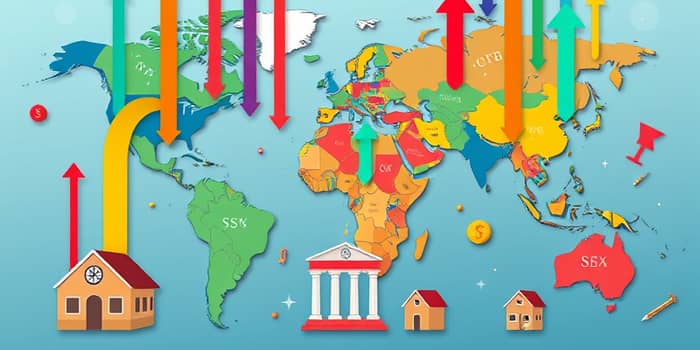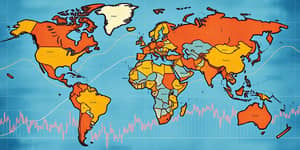In an interconnected world economy, interest rates are one of the most powerful levers that central banks hold. From guiding borrowing costs to steering inflation expectations, changes in benchmark rates ripple across capital markets, influence corporate investment decisions and reshape household budgets. The impact on growth, inflation, trade, and consumer finances has never been more visible as the aftershocks of post-pandemic spending collide with tightening monetary policies.
By early 2025, the Federal Reserve's target range stood at 4.25–4.50%, with market watchers anticipating up to two rate cuts that could lower the benchmark to as low as 3.75–4.00%. At one extreme, Venezuela wrestles with hyperinflation through a policy rate north of 59.4%, while Russia contends with soaring prices and capital flight at a 21% rate. In contrast, Switzerland and Fiji maintain rock-bottom rates of 0.25%, and Japan holds a gentle 0.50% floor. The Bank of England sits at 4.00% with potential downward moves later in 2025, and India’s rate hovers near 5.50%. Even U.S. mortgage rates, though off 2023 peaks, remain historically elevated at roughly 6.8% for a 30-year fixed loan, illustrating how policy decisions echo through everyday life.
Policy Shifts and Divergent Paths
When inflation surged above central banks’ comfort zones in 2022 and 2023, policy rate hikes became heavy and frequent. Since mid-2024, however, a gradual, coordinated easing cycle began mid-2024, reflecting cooling price pressures across major economies. Despite this synchronized shift, the pace and scale of cuts diverge as policymakers balance growth aspirations against the risk of reigniting inflation or stifling recovery.
The Federal Reserve has signaled a cautious stance, targeting two quarter-point cuts in 2025 if data support. The European Central Bank, having ramped its deposit rate from zero to 4.50% over 2022–2023, joined the easing in late 2024. Meanwhile, the Bank of England, facing a “bumpy path” for inflation that may spike near 4% in autumn and then recede, stands ready to adjust rates incrementally.
Monetary Policy Drivers
Central banks weigh a tapestry of economic indicators to inform rate decisions: inflation trajectories, labor market dynamics, GDP growth, and geopolitical risks. In many advanced economies, headline inflation has eased toward the 2% target, but core pressures linger in services, wage growth and housing. Governments also track global supply chains and energy prices, which can reverse gains overnight.
In emerging markets, monetary authorities confront more acute challenges. High inflation expectations, currency depreciation and capital flight often mandate persistent rate premiums, even when external conditions improve. Such divergence underscores the persistent disparities across developed and emerging markets in policy response and economic resilience.
- Inflation control and expectations management
- Employment and wage growth trends
- Geopolitical tensions and energy shocks
- Supply chain disruptions and commodity prices
Regional Highlights
Across North America, the Federal Reserve and the Bank of Canada are poised for modest rate reductions as core inflation stabilizes near 2.5%. Mortgage and consumer credit markets remain sensitive to policy shifts, with affordability pressures easing only gradually.
In Europe, the ECB’s easing cycle follows a steep hiking phase. The Bank of England’s decisions hinge on a projected inflation uptick in autumn and subsequent realignment with target. Meanwhile, Switzerland’s extraordinarily low 0.25% rate contrasts sharply with its export-driven economy.
Asia presents another mosaic of policy choices. Japan’s ultra-low 0.50% benchmark persists, bolstering yen stability. China’s near-zero inflation means limited monetary stimulus, while India’s central bank signals a hold at 5.50% until clear growth indicators appear.
Emerging markets such as Venezuela and Russia illustrate the other extreme, with policy rates at 59.4% and 21% respectively, aimed at quelling hyperinflation, stabilizing currencies and retaining foreign capital.
Key Policy Rates and Inflation (Early 2025)
Sectoral Insights
Housing markets around the globe reveal the tangible side of policy shifts. In the United States, home prices rose 4.5% year-on-year, straining first-time buyers and prompting calls for more affordability measures. The UK mirrored this trend, with property values cooling only slightly despite higher mortgage rates. Australia, Canada and parts of Europe saw similar patterns, where demand outpaced supply, keeping borrowing costs elevated relative to long-term averages.
Consumer credit conditions have also tightened. Credit card rates, personal loans and auto financing reflect central bank actions, squeezing discretionary income and, in some regions, accelerating debt repayment or defaults among vulnerable households. This underscores how a homeownership and consumer credit impact remains elevated, even as some relief filters through monetary easing.
Risks and Uncertainties
Even as headline inflation cools, the prospect of renewed price pressures looms. Central banks cue every policy meeting to recent data, aware that new shocks can derail progress. Uncertainties range from potential energy disruptions to sudden shifts in global trade tensions and emerging health variants.
- Geopolitical tensions and supply disruptions fuel volatility, driving unpredictable commodity shocks and currency swings.
- Energy price spikes in Europe and Asia, triggered by conflicts or production cuts.
- Fiscal stimulus rollbacks or expansions that alter domestic demand patterns.
- Currency instability in high-debt emerging markets, risking financial contagion.
Global Spillovers and Implications
The interest rate landscape shapes capital flows and currency valuations. Higher returns in relatively restrictive economies attract foreign investments, strengthening local currencies but potentially complicating export competitiveness. Conversely, easing cycles in rich nations can prompt portfolio rebalancing, sending capital toward frontier and emerging markets in search of yield.
Regulators and investors watch for emerging-markets vulnerabilities and borrowing costs, as any abrupt policy reversal abroad can trigger debt repayment pressures, inflation resurgence, and credit crunches. Multilateral institutions often step in to provide contingency funding or technical advice, highlighting the interconnected nature of modern finance.
Outlook for 2025–2026
Looking ahead, the major central banks—including the Fed, ECB and Bank of England—anticipate a gradual, careful approach to further cuts. Market consensus suggests limited, stepwise reductions rather than aggressive easing, with projected policy ranges narrowing modestly by year-end 2025.
However, this measured path remains conditional on stable energy markets, resilient supply chains and contained consumer price inflation. Should new risks emerge, central banks will be ready to tighten once more, underscoring the dynamic, ever-evolving nature of monetary policy.
Ultimately, the global interest rate rumble of 2025 is more than a technical debate among economists. It is a story of households deciding whether to buy homes, businesses planning capital expenditures, and governments balancing growth against financial stability. As we navigate the coming months, vigilance, flexibility and coordination will be key to harnessing the benefits of rate moves while mitigating their unintended consequences.
References
- https://www.visualcapitalist.com/sp/ter01-mapped-interest-rates-by-country-in-2025/
- https://www.statista.com/statistics/1317878/inflation-rate-interest-rate-by-country/
- https://www.mycvcu.org/blog/are-mortgage-interest-rates-expecting-to-come-down-in-2025
- https://themortgagereports.com/61853/30-year-mortgage-rates-chart
- https://www.bankofengland.co.uk/explainers/current-interest-rate
- https://www.freddiemac.com/pmms
- https://tradingeconomics.com/forecast/interest-rate
- https://en.macromicro.me/charts/119675/world-central-banks-yearend-interest-rate-expectations-2025










